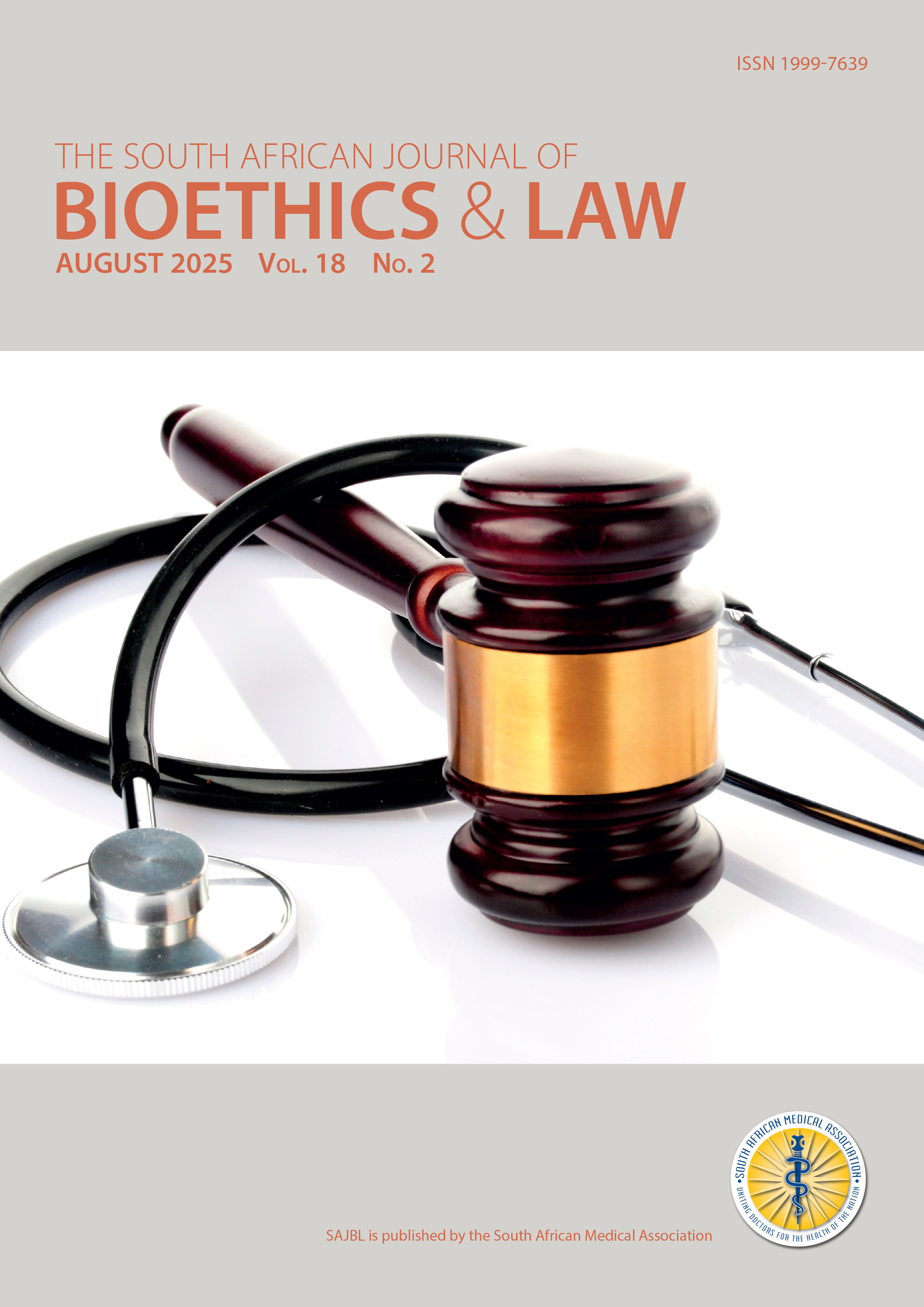In machina: A cursory consideration of artificial wombs and the South African ethico-legal landscape
Main Article Content
Abstract
Preterm birth, defined by the World Health Organization as any birth occurring before 37 weeks of gestation, remains a significant global health challenge, contributing to high rates of neonatal mortality and long‐term complications. In this context, artificial womb technology – or ectogenesis – offers a transformative intervention capable of sustaining extra‐uterine gestation and improving outcomes for extremely preterm infants. This article explores the legal, ethical and societal implications of introducing artificial wombs in South Africa, where existing laws regulating pregnancy, birth and personhood are ill‐equipped to address this technological shift. In particular, the definitional limits of the Choice on Termination of Pregnancy Act, the conditional nature of the nasciturus fiction, and the ambiguity surrounding parental authority and legal guardianship over gestatelings, is analysed. I argue for the development of a bespoke legal framework to regulate ectogenesis, rather than amending existing pregnancy or birth legislation, and propose a set of principles to guide future regulation. Additionally, I highlight how access to artificial wombs may reinforce healthcare inequality if limited to private medical settings. By proactively addressing the legal and policy challenges posed by ectogenesis, South Africa can advance a rights‐based approach to reproductive healthcare while preparing for the ethical and legal complexities of this emerging technology.
This article utilised a qualitative, doctrinal research methodology based on desktop analysis. The research involved the critical examination of primary legal sources such as constitutional provisions, statutes and relevant South African case law. Secondary sources included scholarly articles in medical law, bioethics and reproductive justice, particularly those addressing emerging technologies, e.g. ectogenesis. Comparative perspectives from jurisdictions such as the United Kingdom, the Netherlands, and the United States were also consulted to contextualise the legal challenges within broader international debates. Sources were selected using targeted searches of legal databases and peer‐reviewed journals, with priority given to academic work that engages directly with the ethical, legal and regulatory dimensions of artificial womb technology.
Article Details
Issue
Section

This work is licensed under a Creative Commons Attribution-NonCommercial 4.0 International License.
The SAJBL is published under an Attribution-Non Commercial International Creative Commons Attribution (CC-BY-NC 4.0) License. Under this license, authors agree to make articles available to users, without permission or fees, for any lawful, non-commercial purpose. Users may read, copy, or re-use published content as long as the author and original place of publication are properly cited.
Exceptions to this license model is allowed for UKRI and research funded by organisations requiring that research be published open-access without embargo, under a CC-BY licence. As per the journals archiving policy, authors are permitted to self-archive the author-accepted manuscript (AAM) in a repository.
How to Cite
References
1. World Health Organization. Preterm birth – key facts. Geneva: WHO, 2023. https://www.who.int/news‐room/fact‐sheets/detail/preterm‐birth (accessed 22 November 2023).
2. WorldHealthOrganization,UNICEF,LondonSchoolofHygiene&TropicalMedicine. Born too soon: Decade of action on preterm birth. Geneva: WHO, 2023. https:// www.who.int/publications/i/item/9789240073890 (accessed 1 September 2024).
3. Lawn JE, Blencowe H, Oza S, et al. Every newborn: Progress, priorities, and potential beyond survival. Lancet 2014;384(9938):189‐205.
4. Romanis EC. Artificial womb technology and the frontiers of human reproduction: Conceptual differences and potential implications. J Med Ethics 2018;44:751‐755. 5. Willyard C. Everything you need to know about artificial wombs. MIT Technol Rev 29 September 2023. https://www.technologyreview.com/2023/09/29/1080538/ everything‐you‐need‐to‐know‐about‐artificial‐wombs/ (accessed 1 September
2024).
6. Romanis EC. Artificial womb technology and the frontiers of human
reproduction: Conceptual differences and legal consequences. Medical Law
Review 2020;28(4):738‐753.
7. Dutch Health Council. Ectogenesis: Artificial wombs and the future of neonatal
care. The Hague, 2019.
8. Kipnis K. Does ectogenesis spell the end of abortion? Theoretical Medicine and
Bioethics 2003;24(1):45‐63.
9. United States Food and Drug Administration. Pediatric Advisory Committee
Meeting: Artificial placenta support technology – first‐in‐human protocol considerations. 19 September 2023. https://www.fda.gov/advisory‐committees/ pediatric‐advisory‐committee/presentations‐september‐19‐2023‐meeting‐ pediatric‐advisory‐committee (accessed 1 September 2024).
10. Kozlov M. Human trials of artificial wombs could start soon: Here’s what you need to know. Nature 14 September 2023. https://www.nature.com/articles/d41586‐ 023‐02901‐1 (accessed 22 November 2024).
11. Romanis EC. The ethical and legal status of ‘fetonates’ or ‘gestatelings’. Am J Bioeth 2023;23(5):90‐92.
12. AB & Another v Minister of Social Development & Another [2016] ZACC 43.
13. Christian Lawyers Association v Minister of Health 1998 (4) SA 1113 (T).
14. Christian Lawyers Association of South Africa & Others v Minister of Health &
Others 1998 (11) BCLR 1434 (T).
15. McQuoid‐Mason DJ. Terminating the pregnancy of a brain‐dead mother: Does a
fetus have a right to life? The law in South Africa. S Afr J Bioeth Law 2014;7(2):44‐56. 16. Ex parte Boedel Steenkamp 1962 (3) SA 954 (O).
17. De Bie FR, Chervenak FA, McCullough LB, et al. Ethics considerations regarding
artificial womb technology for the fetonate. Am J Bioeth 2023;23(5):67‐78.
18. Pickles C. Termination‐of‐pregnancy rights and foetal interests in continued existence in South Africa: The Choice on Termination of Pregnancy Act 92 of
1996. PER 2012;15(5).
19. SA government. Births and Deaths Registration Act No. 51 of 1992.
20. World Health Organization. International statistical classification of diseases and
related health problems, 10th rev (ICD‐10). Vol. 2. Geneva: WHO; 2010.
21. Romanis EC. Challenging the ‘born alive’ threshold: Fetal surgery, artificial wombs, and the English approach to legal personhood. Med Law Rev 2020;28(1):93‐123. 22. Romanis EC. Partial ectogenesis: Freedom, equality and political perspective.
J Med Ethics 2020;46(2):89‐90.
23. Fraser v Children’s Court, Pretoria North 1997 (2) SA 261 (CC).
24. SA government. Choice on Termination of Pregnancy Act No. 92 of 1996.
25. Kendal E. Equal opportunity and the case for state‐supported ectogenesis. J Med
Ethics 2017;43(11):710‐714.
26. Cavaliere G. Gestation, equality and freedom: Ectogenesis as a political
perspective. J Med Ethics 2020;46(2):76‐82.
